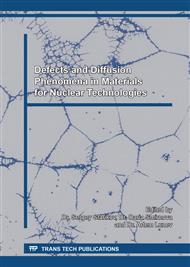[1]
E. E. Bloom et al., Materials to Deliver the Promise of Fusion Power—Progress and Challenges, J. Nucl. Mater., 329-333 A (2004) 12-19.
DOI: 10.1016/j.jnucmat.2004.04.141
Google Scholar
[2]
L. K. Mansur et al., 'Materials Needs for Fusion, Generation IV Fission Reactors and Spallation Neutron Sources - Similarities and Differences, J. Nucl. Mater., 329-333 A 166 (2004) 166-172.
DOI: 10.1016/j.jnucmat.2004.04.016
Google Scholar
[3]
N. Baluc, Materials for Fusion Power Reactors, Plasma Phys. Controlled Fusion, 48 (2006) B165-B177.
DOI: 10.1088/0741-3335/48/12b/s16
Google Scholar
[4]
N.J. Norgett, M.T. Robinson, I.M. Torrens, A proposed method of calculating displacement dose rate, Nucl. Eng. And Design, 33 (1975) 50-54.
DOI: 10.1016/0029-5493(75)90035-7
Google Scholar
[5]
L. Malerba, D. Terentyev, P. Olsson, R. Chakarova, and J. Wallenius, Molecular Dynamics Simulation of Displacement Cascades in Fe-Cr Alloys, J. Nucl. Mater. 329–333 (2) (2004) 1156–1160.
DOI: 10.1016/j.jnucmat.2004.04.270
Google Scholar
[6]
D. A. Terentyev, L. Malerba, R. Chakarova, K. Nordlund, P. Olsson, M. Rieth, and J. Wallenius, Displacement Cascades in Fe–Cr. A molecular dynamics study, J. Nucl. Mater. 349 (1) (2006) 119–132.
DOI: 10.1016/j.jnucmat.2005.10.013
Google Scholar
[7]
J. Wallenius, P. Olsson, C. Lagerstedt, N. Sandberg, R. Chakarova, and V. Pontikis, Modeling of Chromium Precipitation in Fe-Cr Alloys, Phys. Rev. B. 69 (2004) 94103_1–94103_9.
DOI: 10.1103/physrevb.69.094103
Google Scholar
[8]
J.H. Shim, H.J. Lee, and B.D. Wirth, Molecular Dynamics Simulation of Primary Irradiation Defect Formation in Fe–10% Cr Alloy, J. Nucl. Mater. 351 (1–3) (2006) 56—64.
DOI: 10.1016/j.jnucmat.2006.02.021
Google Scholar
[9]
M. Tikhonchev, V. Svetukhin, A. Kadochkin, E. Gaganidze, MD simulation of atomic displacement cascades in Fe–10 at. %Cr binary alloy, J. Nucl. Mater. 395 (2009) 50-57.
DOI: 10.1016/j.jnucmat.2009.09.015
Google Scholar
[10]
M. Tikhonchev, V. Svetukhin, A. Kadochkin, and E. Gaganidze. Molecular Dynamics Simulation of Atomic Displacement Cascades in Fe–9 at % Cr and Fe–9 at % Cr–0. 1 at % C Alloys, Russian Metallurgy (Metally)5 (2011) 415-422.
DOI: 10.1134/s0036029511050132
Google Scholar
[11]
K. Vörtler, C. Björkas, D. Terentyev, L. Malerba, K. Nordlund, The effect of Cr concentration on radiation damage in Fe–Cr alloys, J. Nucl. Mater. 382 (2008) 24–30.
DOI: 10.1016/j.jnucmat.2008.09.007
Google Scholar
[12]
M. Tikhonchev, V. Svetukhin, E. Gaganidze, MD simulation of atomic displacement cascades near chromium-rich clusters in FeCr alloy, J. Nucl. Mater. 442 (2013) S618–S623.
DOI: 10.1016/j.jnucmat.2012.11.058
Google Scholar
[13]
M. Tikhonchev, A. Muralev, V. Svetukhin. MD simulation of atomic displacement cascades in random Fe-9at. %Cr binary alloy with twin grain boundaries, Fusion Science and Technology, 66(1) (2014) 91-99.
DOI: 10.13182/fst13-721
Google Scholar
[14]
K. P. Zolnikov, A. V. Korchuganov, D. S. Kryzhevich, Molecular dynamics simulation of primary radiation damage in Fe–Cr alloy, Journal of Physics: Conference Series 774 (2016) 012130.
DOI: 10.1088/1742-6596/774/1/012130
Google Scholar
[15]
G.J. Ackland, M.I. Mendelev, D.J. Srolovitz, S.W. Han, A.V. Barashev, J, Development of an interatomic potential for phosphorus impurities in α-iron. Phys. Condens. Matter. 16 (2004) S2629-S2642.
DOI: 10.1088/0953-8984/16/27/003
Google Scholar
[16]
P. Olsson, J. Wallenius, C. Domain, K. Nordlund, L. Malerba, Two-band modeling of -prime phase formation in Fe-Cr, PHYSICAL REVIEW B 72 (2005) 214119.
DOI: 10.1103/physrevb.74.229906
Google Scholar
[17]
A. Caro, D. A. Crowson, and M. Caro, Classical Many-Body Potential for Concentrated Alloys and the Inversion of Order in Iron-Chromium Alloys, Phys. Rev. Lett. 95 (2005) 075702.
DOI: 10.1103/physrevlett.95.075702
Google Scholar
[18]
D.J. Bacon, A.F. Calder, F. Gao, Computer simulation of displacement cascade effects in metals, Radiat. Effects Def. Sol. 141 (1997) 283-310.
DOI: 10.1080/10420159708211577
Google Scholar
[19]
S.J. Wooding, D.J. Bacon, W.J. Phythian, A computer simulation study of displacement cascades in α-titanium, Philos. Mag. A 72 (1995) 1261-1279.
DOI: 10.1080/01418619508236254
Google Scholar
[20]
ASTM E521, (E521-89) Practice for Neutron Radiation Damage Simulation by Charged-Particle Irradiation. Annual Book of ASTM Standards, vol. 12. 02, (1995).
Google Scholar
[21]
R. Stoller and L. Greenwood, An evaluation of neutron energy spectrum effects in iron based on molecular dynamics displacement cascade simulations, in: Effects of Radiation on Materials, ASTM STP-1366 (2000) 548–559.
DOI: 10.1520/stp12414s
Google Scholar
[22]
L.R. Greenwood and P.K. Smither, SPECTER: Neutron Damage Calculations for Materials Irradiations, ANL/FPP-TM-197 (1985).
DOI: 10.2172/6022143
Google Scholar
[23]
E. Daum, U. Fischer, Long-term activation potential of the steel eurofer as structural material of a demo breeder blanket, Fusion Engineering and Design, 49–50 (2000) 529–533.
DOI: 10.1016/s0920-3796(00)00274-x
Google Scholar
[24]
C. Björkas, K. Nordlund, L. Malerba, D. Terentyev, P. Olsson, Simulation of displacement cascades in Fe90Cr10 using a two band model potential, J. Nucl. Mater. 372, Issues 2–3 (2008) 312–317.
DOI: 10.1016/j.jnucmat.2007.03.265
Google Scholar
[25]
S.L. Dudarev, The non-Arrhenius migration of interstitial defects in bcc transition metals, Comptes Rendus Physique, Vol. 9, Iss. 3–4 (2008) 409-417.
DOI: 10.1016/j.crhy.2007.09.019
Google Scholar
[26]
P. M. Derlet, D. Nguyen-Manh, S. L. Dudarev, Multiscale modeling of crowdion and vacancy defects in body-centered-cubic transition metals, Phys. Rev. B 76 (2007) 054107.
DOI: 10.1103/physrevb.76.054107
Google Scholar


